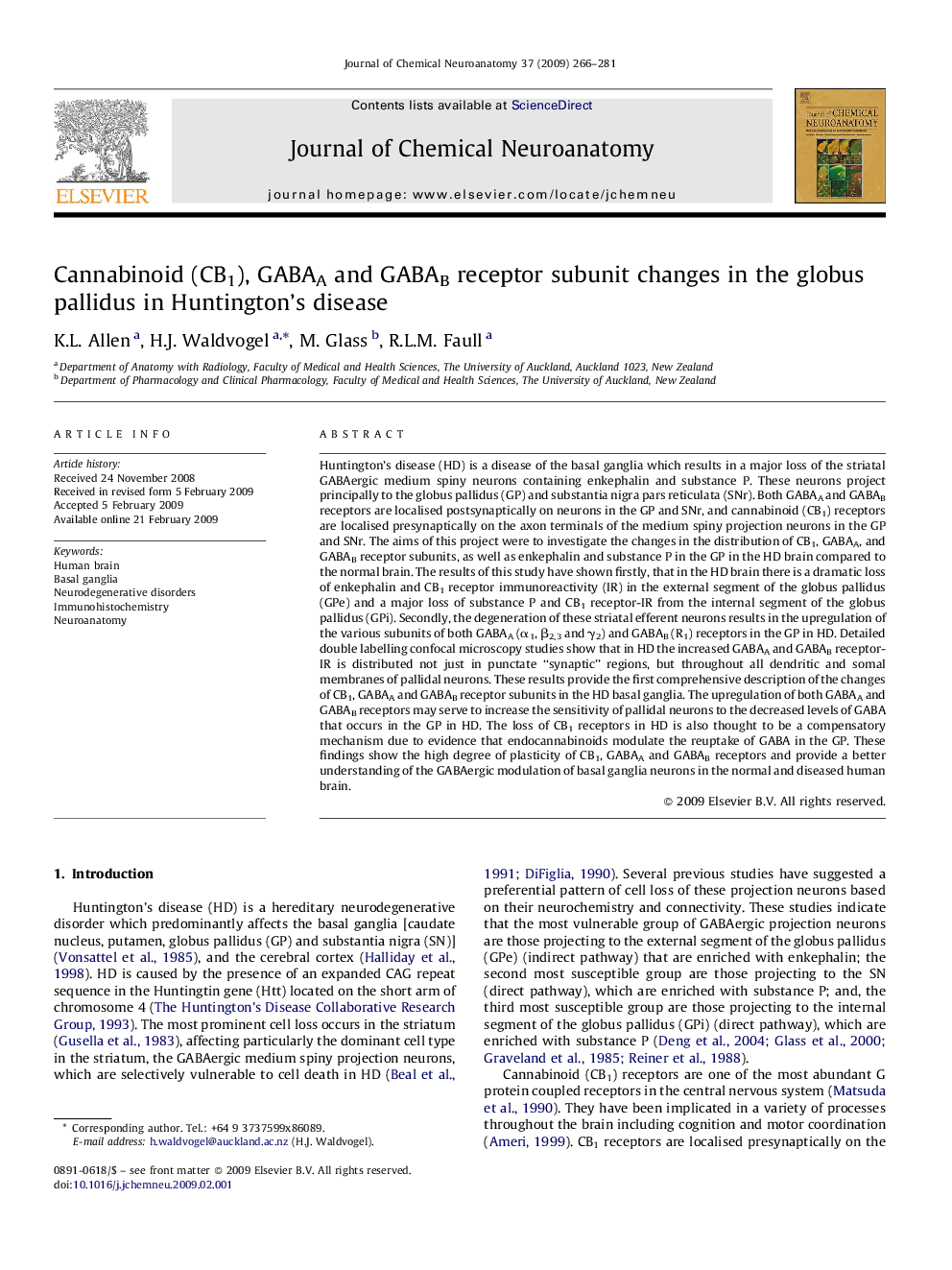| کد مقاله | کد نشریه | سال انتشار | مقاله انگلیسی | نسخه تمام متن |
|---|---|---|---|---|
| 1989185 | 1063571 | 2009 | 16 صفحه PDF | دانلود رایگان |
عنوان انگلیسی مقاله ISI
Cannabinoid (CB1), GABAA and GABAB receptor subunit changes in the globus pallidus in Huntington's disease
دانلود مقاله + سفارش ترجمه
دانلود مقاله ISI انگلیسی
رایگان برای ایرانیان
کلمات کلیدی
موضوعات مرتبط
علوم زیستی و بیوفناوری
بیوشیمی، ژنتیک و زیست شناسی مولکولی
زیست شیمی
پیش نمایش صفحه اول مقاله

چکیده انگلیسی
Huntington's disease (HD) is a disease of the basal ganglia which results in a major loss of the striatal GABAergic medium spiny neurons containing enkephalin and substance P. These neurons project principally to the globus pallidus (GP) and substantia nigra pars reticulata (SNr). Both GABAA and GABAB receptors are localised postsynaptically on neurons in the GP and SNr, and cannabinoid (CB1) receptors are localised presynaptically on the axon terminals of the medium spiny projection neurons in the GP and SNr. The aims of this project were to investigate the changes in the distribution of CB1, GABAA, and GABAB receptor subunits, as well as enkephalin and substance P in the GP in the HD brain compared to the normal brain. The results of this study have shown firstly, that in the HD brain there is a dramatic loss of enkephalin and CB1 receptor immunoreactivity (IR) in the external segment of the globus pallidus (GPe) and a major loss of substance P and CB1 receptor-IR from the internal segment of the globus pallidus (GPi). Secondly, the degeneration of these striatal efferent neurons results in the upregulation of the various subunits of both GABAA (α1, β2,3 and γ2) and GABAB (R1) receptors in the GP in HD. Detailed double labelling confocal microscopy studies show that in HD the increased GABAA and GABAB receptor-IR is distributed not just in punctate “synaptic” regions, but throughout all dendritic and somal membranes of pallidal neurons. These results provide the first comprehensive description of the changes of CB1, GABAA and GABAB receptor subunits in the HD basal ganglia. The upregulation of both GABAA and GABAB receptors may serve to increase the sensitivity of pallidal neurons to the decreased levels of GABA that occurs in the GP in HD. The loss of CB1 receptors in HD is also thought to be a compensatory mechanism due to evidence that endocannabinoids modulate the reuptake of GABA in the GP. These findings show the high degree of plasticity of CB1, GABAA and GABAB receptors and provide a better understanding of the GABAergic modulation of basal ganglia neurons in the normal and diseased human brain.
ناشر
Database: Elsevier - ScienceDirect (ساینس دایرکت)
Journal: Journal of Chemical Neuroanatomy - Volume 37, Issue 4, July 2009, Pages 266-281
Journal: Journal of Chemical Neuroanatomy - Volume 37, Issue 4, July 2009, Pages 266-281
نویسندگان
K.L. Allen, H.J. Waldvogel, M. Glass, R.L.M. Faull,